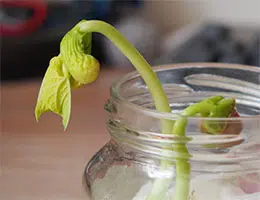 The act of germinating is called germination . The concept comes from the Latin word germinatio . The verb germinate , for its part, refers to beginning to develop or sprout.
The act of germinating is called germination . The concept comes from the Latin word germinatio . The verb germinate , for its part, refers to beginning to develop or sprout.
If we focus on the field of botany, the idea of germination is linked to the development of a plant from the seed : that is, from the part of the fruit that houses the embryo of a new specimen.
Germination, therefore, is a process that begins with the development of the embryo and continues until the birth of a plant . For germination to occur, certain conditions of temperature, availability of water and nutrients, etc. are needed. The seed must also be in the appropriate medium. Once the process is triggered, if it is deployed successfully it will culminate in the appearance of a new plant.
For the seed to form, an antherozoid (male gamete) must reach the ovary and enter the ovule (female gamete). There fertilization takes place and the ovule ends up becoming a seed, while the ovary takes the form of a fruit .
Germination follows a rest phase and involves the resumption of growth of the embryo, which is dry. With the addition of water, the embryo swells until it manages to break the seed envelope. This is how the sprout arises, which begins with the appearance of the radicle . In the case of phanerogamous plants, the first leaf of the embryo is called the cotyledon : upon receiving the sun's rays, the cotyledon can develop photosynthesis and thus the plant survives and grows.
 The germination process is usually part of the primary school curriculum. This is a very suitable experiment to get city children closer to nature and see with their own eyes how their food grows, for example. Needless to say, in the countryside education oriented towards agriculture is very common, and at home they learn these and other things from a young age.
The germination process is usually part of the primary school curriculum. This is a very suitable experiment to get city children closer to nature and see with their own eyes how their food grows, for example. Needless to say, in the countryside education oriented towards agriculture is very common, and at home they learn these and other things from a young age.
Parents can do the germination experiment on their own, without waiting for teachers to demand it from their children, since it is an excellent opportunity to share with them the magic that is the cycle of life, not so different between the plants and us. The normal thing is to use a bean, since it germinates quite easily, although this does not mean that it does not require attention and care.
Through the germination experiment, it is easier to know each of the parts of the plant, since we see step by step how they are formed. In addition, it is ideal for developing children's patience, love and respect for other living beings, three essential values to integrate into society in a healthy way. Another aspect of the person that is reinforced through germination is responsibility : if we neglect the seed for too long, the experiment is ruined.
The materials needed for germination are beans, a glass jar, cotton and water . First, place the cotton in the jar, without crushing it. Then, the beans, leaving enough space between them. Next, the cotton should be slightly moistened. Finally, we must place the jar where it receives sunlight. We must moisten the cotton once a day throughout the entire process.
In a matter of days, if everything goes well, several plants are born and develop very quickly. After a week from the beginning, it is likely that we can plant the sprouts in the ground so that they continue growing in the most natural way possible.
